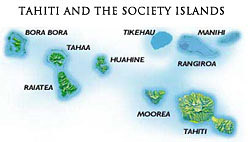Regions - French Polynesia
Many consider Tahiti and its surrounding islands to be the epitome of tropical. Including Tahiti, Bora Bora, Moorea and others, these islands are known for dramatic landscapes, bright blue waters that support about every water sport you can think of, Polynesian culture, World War II history and truly getting away from it all. About 80% of the islands' visitors are honeymooners, but fortunately there are plenty of uninhabited motus (islets) for all.
The different islands have much in common, so how do you choose?

Tahiti
Tahiti is the largest island and the administrative center of French Polynesia. Papeete, its capital, is therefore one of the livelier places around. Gambling, shopping, artisans, dining and nightlife are plenty. Many of the region's cultural and historical museums reside here. Tahiti is the only island with a golf course, so get your fix here if you need it. As with the other islands, Tahiti has excellent access to water sports and lush vegetation, although the best reason to come here is for a little action before really kicking back in a more out of the way place.
Bora Bora
Bora Bora is perhaps one of the most recognized islands in the world for its unique topography - a mountainous island rises from the water, and is encircled by smaller, flat islands, almost like a bullseye. Most of the lodging resides on this ring, with views back at the mountain - extremely beautiful. Watersports, hiking, World War II historic sites, relaxation, flowers and the views will rule your days here.
Moorea
Moorea is perhaps the more rugged of the islands of the main islands, which makes it particularly interesting and attractive to those who enjoy hiking and horseback riding. It is often likened to James Michener's mythical Island of Bali Hai. As one of the larger islands, you also have access to a wide variety of dining options, and the full range of water sports, including 20 different dive locations and numerous submarine excursions!
Rangiroa
Rangiroa is an atoll, or rather, a ring of coral islets surrounding a very large, blue lagoon. Given its formation, this is the premier spot for scuba divers and snorkelers in the Society Islands - marine life abounds. It's also a small, uncomplicated place - outside the water your touring options are a couple of towns and some bird sanctuaries. For such an uninhabited locale, it has some terrific accommodations, including Kia Ora Sauvage, where you receive outstanding service but are completely unplugged from the modern world - no electricity!
Huahine
Huahine is comprised of two islands connected by a bridge, and is relatively undeveloped compared to others in the region. For those particularly interested in ancient Polynesian culture, Huahine has several monoliths and other landmarks known as "marae". Huahine is also a good bet for extended horseback rides (1-2 days) into the plantations, mountains and various beaches. A good mix of archeological sites, geological formations and beach.
Raiatea
Raiatea and neighboring Taha'a are only a short boat ride apart but are very different. Taha'a has small town ambiance and a more rugged landscape, whereas Raiatea is relatively more bustling. Four-wheel drive tours are a good way to get to know the differences as well as smell the fresh vanilla from the plantations. A side benefit to these two is Vahine Island, just off Raiatea, which is one of the islands' only small resorts (9 bungalows) where you can really get away from civilization but still be pampered.
Marquesas Islands
The Marquesas Islands are a bit further away from the rest, but are an interesting possibility for those who want a more adventurous stint on the islands. About 3 hours by plane from Papeete, the main islands of Nuku Hiva and Hiva Oa have dense jungles which offer extended horseback riding excursions, 4x4 safaris, hidden water falls and a look at what undeveloped French Polynesia truly is. Important to note is that the Marquesas' coastline is mostly made up of cliffs, so going to the beach here is not really an option. You can spend time on the water, including sailing, scuba diving, fishing and island boat tours.




